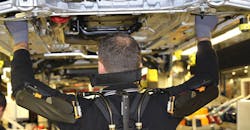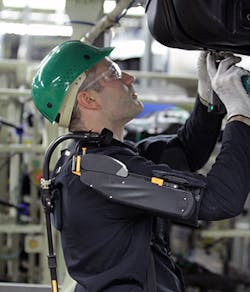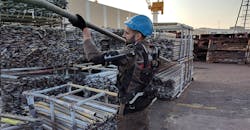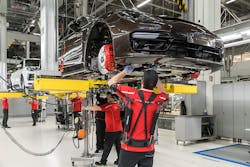Can Exoskeletons Raise Depressing Workforce Stats?
The main purpose of the industrial exoskeleton, as with any piece of PPE, is to keep the workers safe, to keep them working. Granted, these are cool, sci-fi looking pieces of PPE that will have co-workers joke about Ellen Ripley (Aliens) or Tony Stark (Iron Man). But their primary mission is to prevent some of the costliest, most pervasive injuries—musculoskeletal disorders (MSDs)— which are caused simply by doing your job day in and day out for years and years. This could include reaching up to screw in 1,000 lightbulbs a day, or fastening parts to a car's undercarriage using an impact wrench.
OSHA's 2014 report indicated one-third of all lost workdays in the U.S. were due to MSDs, largely preventable injuries that cost upwards of $20 billion in direct costs and $100 billion in indirect costs per year. More recently, the 2018 Liberty Mutual Workplace Safety Index found overexertion injuries alone carry a $13.7 billion annual cost and comprise 23% of the overall national burden.
Toyota took the first steps in a revolutionary prevention strategy, possibly redefining American worker safety in the process. Last November, the automaker made exoskeletons mandatory personal protective equipment (PPE) for overhead work in its Toyota Canada plant in Ontario, and in March at Toyota Motor Manufacturing Indiana. More than 350 Levitate Airframe exoskeletons—metal and fabric devices worn like a backpack that brace the arms and reduce muscle fatigue during repetitive tasks—are in use at these two facilities for inspection and assembly.
This could be the start of a new safety SOP that will not only keep workers from missing a few days or several months due to MSDs, like a torn rotator cuff, but also entice snowflakes young people back to historically intensive labor. Because wearable machines will be sharing the load, a hard day's work won’t be as hard on the body.
This brand of lightweight passive exoskeleton was engineered by San Diego-based Levitate Technologies, originally designed as medical supports to assist surgeons for lengthy surgeries. Using a proprietary pulley system, they reduce muscle activity in shoulders and arms by 10-30%. That might not seem like much, but for workers holding a drill or welding torch (there's a fire-resistant version available) above their head most of the day is truly significant. Studies show it's enough to delay the onset of fatigue and improve worker quality over a longer period.
Data collected from virtual welding simulator at Vermeer showed an expert welder wearing the Airframe doubled his weld accuracy score from the test he did two days prior without it, which started to decline towards the end of that initial 90-minute session.
An Iowa State study conducted at Toyota Canada using electromyography (EMG) "found a 20% average reduction in muscle load," explains Joseph Zawaideh, Levitate’s VP of Marketing and Business Development. A similar scientific study was done at two John Deere sites.
The Airframe had previously earned a CE marking for PPE in Europe and has been used at BMW's Spartanburg, S.C., plant for overhead assembly, like using a pneumatic drill for fastening tasks. With the preponderance of positive lab results, it's not hard to see why Toyota would kick the tires on the tech as a permanent solution.
And as manufacturers have copied the Toyota Production system, they may play follow the leader here as well. They have plenty of options from which to choose.
Expanding Field
The arm-assist subgroup alone has several worthy competitors being used at manufacturers around the world. Levitate says the Airframe alone is at 100 companies. And it's certainly not the only player in the category.
Ford, which has also deployed the Airframe at its engine and transmission plants, is halfway through a two-year study to vet the efficacy of the EksoVest, a competing upper body exoskeleton. The automaker is also experimenting with the suitX ShoulderX V3 and Ottobock Paexo.
This is the third version of the ShoulderX, and the company has attached a cooling fan to the back to make wearing the device a less sweaty affair.
"Worker's acceptance is a huge deal. If they don’t like it, they don’t wear it," says suitX CEO Homayoon Kazerooni, the man largely responsible with developing the modern exoskeleton 20 years ago for the military.
And with acceptance comes the two-fold benefit of safer and more productive workers. That's at least what wind turbine manufacturer Siemens Gamesa is looking to achieve with their ShoulderX deployments at their facilities.
"Ideally, we will see a lower level of injuries and tiredness and a higher level of productivity, showing that you can do good for the company and do good for your employees at the same time," says Claus Lindberg Nielsen, head of tooling at Siemens Gamesa. "We always aim to improve our employee health and working conditions and if we can do that, and at the same time save 30 seconds on a process that is repeated 1,000 times, that truly is a win for all."
Raising Up the Workforce
Ottobock, a century-old prosthetics manufacturer which entered the industrial exo market last October with the 4-lb. Paexo, mentions on its website that in 2017, specifically for the European building industry, more than one in four (27%) of sick days were due to musculoskeletal injuries. For building and drywall construction, it was one in three.
That makes sense because a muscle injury takes a lot longer to recover from than the much more common flu. According to the U.S. Bureau of Labor Statistics, MSDs require "a median of 11 days away from work to recover." And rotator cuff surgery could put a worker out of commission for three to eight months, (more if you’re the best company softball pitcher and they spring for Tommy John surgery).
Obviously, it's in the best interest of everyone— from the workman's comp provider to the plant manager to the actual worker—to avoid these injuries. But it's even more vital to keep employees healthy in the face of an ever-widening skills gap.
According to the 2014 Manufacturing Skills & Training Study, "80% of manufacturers report[ed] a moderate or serious shortage of qualified applicants for skilled and highly skilled production positions."
The Manufacturing Institute and Deloitte's 2018 Skills Gap study found that less than half of the 4.6 open manufacturing jobs over the next decade will be filled. And specifically, for production workers, it has taken a third longer in 2018 to place a vacant position (93 days) than in 2015 (70 days).
According to OfficeTeam, 87% of U.S. workers age 18-34 (Millennials) factor health and wellness offerings in making a job decision. For 55+, it's only 44%. A company that wants to attract the largest pool of talent needs to stand out in this category, and exoskeletons not only transfer loads and torque, but also their inherent "cool" factor directly to the employer investing in them.
And it's a small investment all things considered.
The predicted future GDP loss is in the trillions, but this next stat courtesy of the National Association of Manufacturers drops a crushing reality: In Q1 of this year, one out of every four manufacturers turned down new business opportunities because they lacked the workers.
This year. Now. The year Blade Runner took place, when we thought androids and flying cars would solve all our problems, we can’t keep loyal workers on the line busting their butts from bursting their bursas. They are recovering from surgery while sales is in meltdown mode because they lost a huge commission.
That's the clear and present danger, and automation cannot always be the solution. Robots and automated machines have become indispensable tools in certain simple and light applications, but more often than not, they can't mimic the value of even your weakest worker. As a bit of proof, Deloitte says only 53% of those surveyed for the 2018 Global Human Capital Trends report are "redesigning work around automation." If robots were the panacea to address the workforce issues of the next decade, you'd expect that number to be higher.
For now, at least, people are still powering production, and despite the depressing stats, the rise of industrial exoskeletons should have us all feeling a bit more upbeat.
"It's getting a step closer to becoming mainstream,” Zawaideh says of the exoskeleton reaching PPE status. “You're not going to say this is a great piece of innovation anymore; it's going to be like safety glasses.”
And to push the effort along even more, ASTM International, which is working on creating exoskeleton standards, just announced an RFP for an Exo Technologies Center of Excellence that would spur exosuit and exoskeleton innovation, act as a hub for education and training and coordinate global partnerships. For support, the winning bid will get $250,000 annually for up to five years including funds and in-kind contributions, ASTM says.
Proposals are welcome from R&D entities, universities, government agencies, and other stakeholders worldwide. Letters of intent are due June 27 with any questions due June 28. An informational webinar will follow July 2 for applicants, whose full proposals are due July 29. The winning proposal will be announced no earlier than September.
About the Author
John Hitch
Senior Editor
John Hitch writes about the latest manufacturing trends and emerging technologies, including but not limited to: Robotics, the Industrial Internet of Things, 3D Printing, and Artificial Intelligence. He is a veteran of the United States Navy and former magazine freelancer based in Cleveland, Ohio.
Questions or comments may be directed to: [email protected]




